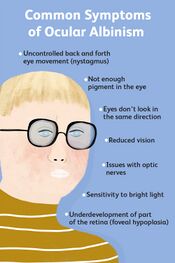Albinism: Difference between revisions
A Aishwarya (talk | contribs) No edit summary |
A Aishwarya (talk | contribs) No edit summary |
||
| Line 78: | Line 78: | ||
== Clinical Presentation == | == Clinical Presentation == | ||
[[File:Ocular-albinism-5201966 final rev-2a520b29d6fe41e98ee71f27c82ba674.jpg|thumb]] | [[File:Ocular-albinism-5201966 final rev-2a520b29d6fe41e98ee71f27c82ba674.jpg|thumb|263x263px]] | ||
# Very light skin and hair ranging from white and blond to light brown. | # Very light skin and hair ranging from white and blond to light brown. | ||
Revision as of 21:09, 25 November 2023
This article or area is currently under construction and may only be partially complete. Please come back soon to see the finished work! (25/11/2023)
Introduction[edit | edit source]
Albinism, a latin word albus that means "white" is a genetic condition characterised by a lack of melanin.[1] Melanin is a pigment that gives colour to the hair, skin and eyes. It is an inherited when an individual receives two copies of a recessive gene that causes a lack of melanin production. There are different types of albinism.
- Oculocutaneous Albinism (OCA): This affects the person's skin, hair, and eyes. Due to little or no melanin in these areas, the skin and hair color is very light with blue or violet eyes. OCA is further subdivided into (based on mutations invovled):
- OCA1
- OCA2
- OCA3
- OCA4
- Ocular Albinism (OA): This primarily affects the eye. These individuals may have little or no pigmentation in the iris and retina that leads to vision problem. In OA the skin and hair colour might appear normal. This is associated with issues such as Nystagmus and strabismus.[2]
Relavent Anatomy[edit | edit source]
Skin[edit | edit source]
The skin has three layers namely, Epidermis - Outermost layer, Dermis - Provides support and nourishment, Hypodermis - Deepest layer. There are various cells that are present in the epidermis and dermis that contribute to the structure and function of skin such as Keratinocytes, Melanocytes, Langerhans cells, Fibroblasts, Adipocytes and Mast cells.
The Melanocytes are the cells that produce a pigment named melanin that gives colour to the skin, hair and eyes.[3]
Genetic Mutation[edit | edit source]
Genes are segments of DNA that determines the way for the synthesis of proteins and other molecules. Mutation in albinism affect specific genes that responsible for various functions. These include:
- TYR (Tyrosinase) Gene: This gene provides instruction for the production of tyrosinase that is crucial for melanin synthesis. Due to mutation in this gene there is insufficient or nonfunctional tyrosinase, thus leading to lack of melanin.
- OCA2 Gene: This gene is associated with the regulation of melanin production and distribution. A mutation in the gene affects the quantity and distribution of melanin in the skin, hair and eyes.
- TYRP1(Tyrosinase- Related Protein 1) Gene: This provides instructions for the production of tryosinase-related protein 1, which involved in melanin synthesis and maturation. A mutation can impair the synthesis and maturation of melanin.
- SLC45A2 Gene: The gene is associated with the transport of melanin precursors within melanocytes. The mutation can disrupt the normal transport of melanin precursors, affecting the production and distribution of melanin.
- GPR143 Gene: This gene is associated with OA and plays a role in the development and function of the eyes. The mutation in this gene can impact the development of the optic nerve and other structures in the eyes, leading to visual impairments.[4]
Sub-Types of Albinism[2][4][edit | edit source]
| OCA1[5] | OCA2 | OCA3 | OCA4 |
|---|---|---|---|
| Mutations in TYR Gene
Chromosome 11 Tyrosine deficiency |
Mutations in OCA2 Gene
Chromosme 15 Melanosomal membrane protein |
Mutations in TYRP1 Gene
Chromosome 9 Stabilizes Tryosinase |
Mutations in SLC45A2 Gene
Chromosome 5 Membrane Transport protein |
| OCA1a: Complete absence of melanin
OCA1b: Some melanin present |
Brown OCA | Red OCA | Nearly normal melanin |
| Most common globally | Common in people of African | Common in southern Africa | Common in East Asian |
Causes of albinism[edit | edit source]
- Genetic basis: Albinism is primarily a genetic disorder, hence involves mutation of genes
- In OCA mutation in genes such as TYR, OCA2, TYRP1 ans SLC45A2 can lead to disruption in melanin synthesis or transport.
- In OA, mutations in GPR143 gene in seen.
- Melanin production: Due to genetic mutations, there is a disruption in the function of melanocytes/Tyrosinase.
- Melanin Distribution: Melanin has to be effectively transferred from melanocytes to surrounding cells in the hair, skin and eyes. In some cases, there may be defects in the transfer or distribution, hence resulting in the pigmentation of tissues.
Clinical Presentation[edit | edit source]
- Very light skin and hair ranging from white and blond to light brown.
- Eye colour can be blue, violet or light grey.
- Lack of Melanin in the iris can lead to increased sensitivity to light.
- Reduced visual acuity is common.
- Nystagmus that can affect the ability to maintain steady visual focus.
- Strabismus (crossed or misaligned eyes) may be present.
- Optic nerve abnormalities.
- Increased susceptibility to sunburn.
Management/Interventions[edit | edit source]
Current Literature[edit | edit source]
Refrences[edit | edit source]
- ↑ Kruijt CC, de Wit GC, Bergen AA, Florijn RJ, Schalij-Delfos NE, van Genderen MM. The phenotypic spectrum of albinism. Ophthalmology. 2018 Dec 1;125(12):1953-60.
- ↑ 2.0 2.1 Marçon CR, Maia M. Albinism: epidemiology, genetics, cutaneous characterization, psychosocial factors. Anais brasileiros de dermatologia. 2019 Dec 9;94:503-20.
- ↑ Thawabteh AM, Jibreen A, Karaman D, Thawabteh A, Karaman R. Skin Pigmentation Types, Causes and Treatment—A Review. Molecules. 2023 Jun 18;28(12):4839.
- ↑ 4.0 4.1 Yang Q, Yi S, Li M, Xie B, Luo J, Wang J, Rong X, Zhang Q, Qin Z, Hang L, Feng S. Genetic analyses of oculocutaneous albinism types 1 and 2 with four novel mutations. BMC medical genetics. 2019 Dec;20:1-1.
- ↑ Arveiler B, Michaud V, Lasseaux E. Albinism: an underdiagnosed condition. Journal of Investigative Dermatology. 2020 Jul 1;140(7):1449-51.











